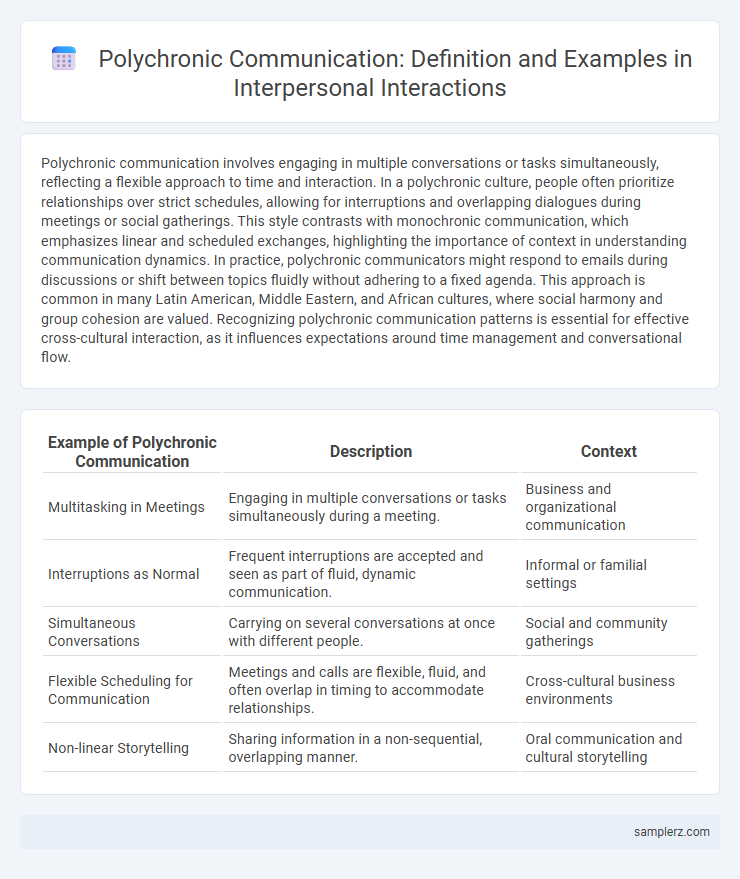Polychronic communication involves engaging in multiple conversations or tasks simultaneously, reflecting a flexible approach to time and interaction. In a polychronic culture, people often prioritize relationships over strict schedules, allowing for interruptions and overlapping dialogues during meetings or social gatherings. This style contrasts with monochronic communication, which emphasizes linear and scheduled exchanges, highlighting the importance of context in understanding communication dynamics. In practice, polychronic communicators might respond to emails during discussions or shift between topics fluidly without adhering to a fixed agenda. This approach is common in many Latin American, Middle Eastern, and African cultures, where social harmony and group cohesion are valued. Recognizing polychronic communication patterns is essential for effective cross-cultural interaction, as it influences expectations around time management and conversational flow.
Table of Comparison
| Example of Polychronic Communication | Description | Context |
|---|---|---|
| Multitasking in Meetings | Engaging in multiple conversations or tasks simultaneously during a meeting. | Business and organizational communication |
| Interruptions as Normal | Frequent interruptions are accepted and seen as part of fluid, dynamic communication. | Informal or familial settings |
| Simultaneous Conversations | Carrying on several conversations at once with different people. | Social and community gatherings |
| Flexible Scheduling for Communication | Meetings and calls are flexible, fluid, and often overlap in timing to accommodate relationships. | Cross-cultural business environments |
| Non-linear Storytelling | Sharing information in a non-sequential, overlapping manner. | Oral communication and cultural storytelling |
Understanding Polychronic Communication
Polychronic communication emphasizes multitasking and flexible time management, where speakers often engage in multiple conversations or activities simultaneously. This style prioritizes relationship-building and context over strict adherence to schedules, leading to fluid and overlapping interactions. Understanding polychronic communication helps in appreciating how individuals from cultures like Latin America or the Middle East value personal connections and adapt communication accordingly.
Key Characteristics of Polychronic Cultures
Polychronic communication emphasizes multitasking and fluid time management, where individuals prioritize relationships over strict adherence to schedules. Key characteristics include simultaneous handling of multiple conversations, flexible deadlines, and a strong focus on interpersonal connections and emotional cues. This approach often leads to dynamic, context-rich interactions that value collaboration and personal involvement over punctuality and linear processes.
Real-Life Examples of Polychronic Communication
Polychronic communication is evident in Mediterranean and Latin American cultures where multitasking and fluid schedules shape interactions, such as hosting social conversations while conducting business meetings. In these settings, interruption is often seen as a sign of engagement rather than rudeness, reflecting a flexible approach to time and communication. Real-life examples include family gatherings where multiple topics are discussed simultaneously and negotiations occurring in a dynamic, overlapping dialogue.
Polychronic Communication in the Workplace
Polychronic communication in the workplace involves managing multiple conversations and tasks simultaneously, reflecting a cultural preference for multitasking and flexible scheduling. Employees in polychronic environments often prioritize relationships over strict adherence to schedules, enabling dynamic interactions and collaborative problem-solving. This communication style fosters an adaptable work atmosphere where interruptions are common and time is viewed as fluid rather than linear.
Social Interactions in Polychronic Settings
In polychronic communication settings, social interactions involve managing multiple conversations or activities simultaneously, reflecting a flexible approach to time and relationships. Participants often prioritize personal connections over strict adherence to schedules, engaging in overlapping discussions and non-linear exchanges that enhance relational depth. This dynamic promotes a rich, context-driven communication style commonly observed in cultures valuing multitasking and collective participation.
Family Dynamics and Polychronic Communication
In family dynamics, polychronic communication emphasizes multitasking and overlapping conversations where family members engage simultaneously in various activities and interactions. This communication style fosters a fluid exchange of information, allowing emotional expression and relationship maintenance to occur naturally within the household environment. Polychronic families prioritize relational bonds and presence over strict adherence to schedules or linear conversational turns.
Polychronic Time Management in Meetings
Polychronic time management in meetings allows multiple conversations and tasks to occur simultaneously, promoting flexibility and dynamic interaction among participants. This approach supports relationship-building and responsiveness, often seen in cultures where multitasking and fluid scheduling are valued over strict adherence to agendas. Emphasizing collective presence and adaptability, polychronic communication enhances collaboration by accommodating interruptions and overlapping discussions without disrupting the overall meeting flow.
Cross-Cultural Differences: Polychronic vs. Monochronic
Polychronic communication, common in Latin American and Middle Eastern cultures, emphasizes multitasking and flexible time management, where conversations often overlap and social relationships take precedence over schedules. In contrast, monochronic cultures like the United States and Germany prioritize punctuality, linear conversations, and task-oriented communication. Understanding these cross-cultural differences is crucial for effective global communication, as misinterpretations can arise from varying perceptions of time and interaction styles.
Challenges of Polychronic Communication
Polychronic communication, characterized by multitasking and simultaneous interactions, often leads to challenges such as misunderstandings and reduced message clarity. The frequent interruptions and overlapping conversations can cause confusion, making it difficult for participants to follow the main topic or retain important details. This communication style may hinder effective information exchange in professional settings where focused and sequential dialogue is essential.
Strategies for Effective Communication in Polychronic Cultures
In polychronic cultures, effective communication strategies emphasize multitasking and flexibility, allowing simultaneous engagement in multiple conversations or activities. Prioritizing relationship-building over strict adherence to schedules enhances trust and collaboration, fostering a more dynamic flow of information. Utilizing nonverbal cues and context also plays a critical role in ensuring clarity and mutual understanding within polychronic communication environments.

example of polychronic in communication Infographic
 samplerz.com
samplerz.com